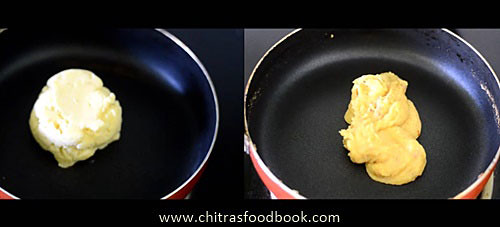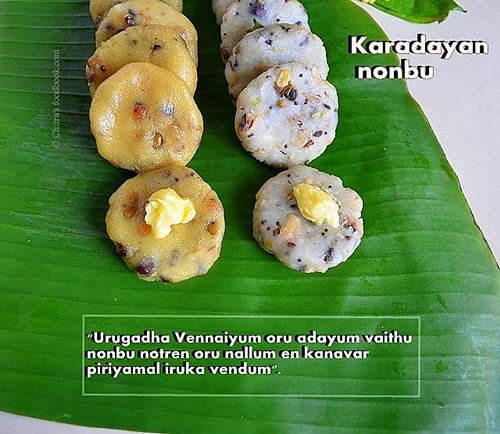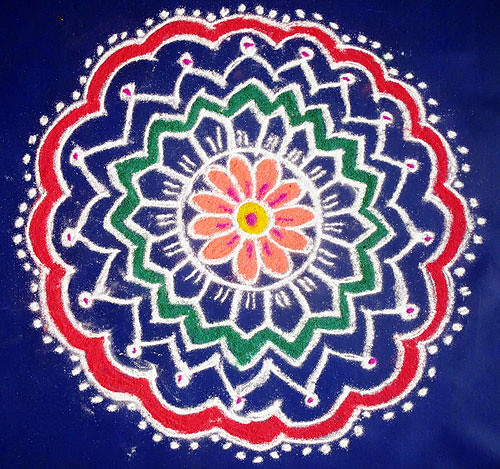
Pages
- Home
- About me
- Recipe index
- Chutney Recipes
- Kuzhambu Recipes
- Biryani-Pulao-Recipes
- Side dish for roti
- Bachelors Recipes
- Paneer Recipes
- No onion No garlic recipes
- Millet & Oats Recipes
- Cakes & Cookies
- Kids recipes list
- Cooking Videos
- Indian Grocery list - South Indian Monthly Grocery Shopping List
- Ragi Recipes
- Summer Recipes
- Mango Recipes
- Cooking basics
- Lunch menu & Party ideas
- Tips Tips
- Readers voices
- Search In Chitra's Food Book
- Aadi Recipes
Search Chitra's Food Book
March 25, 2016


Paneer Makhani – Paneer Makhanwala Recipe

March 23, 2016


Carrot Beans Poriyal Recipe - Carrot Beans Curry With Moong Dal

Earlier I used to follow my MIL’s method. But nowadays I make this poriyal easily in a pressure cooker in one go. I make it mostly in busy morning hours using my small 1.5 ltr Pressure Cooker. It gets ready in just 10 minutes apart from chopping. Its a very easy & healthy stir fry that can be made with or without coconut and onion. Most of the time I avoid using both of them. So its purely a bachelors style recipe. Its a good side dish for Sambar, Rasam and curd rice. Thanks to my MIL for teaching me this yummy South Indian poriyal recipe. Ok, lets see how to make Carrot beans poriyal for rice with a video.
Check out my other poriyal recipes HERE.
Check out my other poriyal recipes HERE.
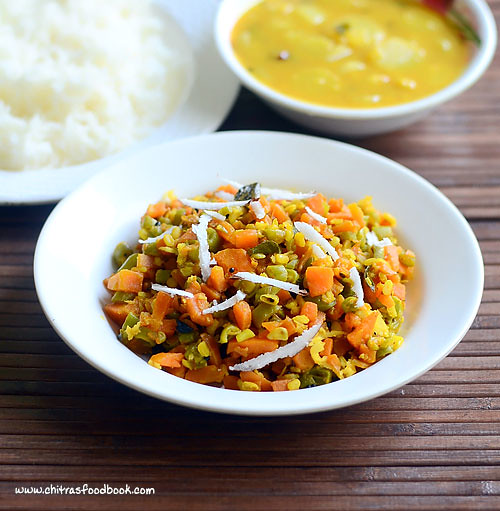
Carrot beans poriyal recipe
 Carrot beans poriyal - How to make carrot bean stir fry using a pressure cooker - Side dish for rice
Carrot beans poriyal - How to make carrot bean stir fry using a pressure cooker - Side dish for rice
Cuisine: Indian
Category: Side dish
Serves: Serves 2
Prep time: 10 Minutes
Cook time: 10 Minutes
Total time: 20 Minutes
INGREDIENTS
|
HOW TO MAKE CARROT BEANS PORIYAL - METHOD
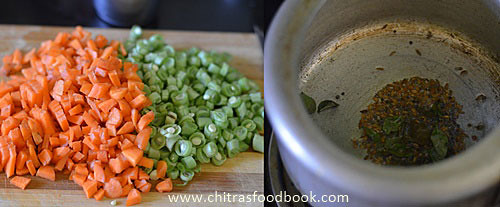
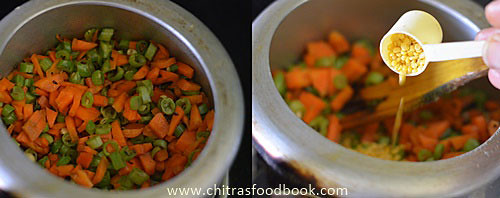
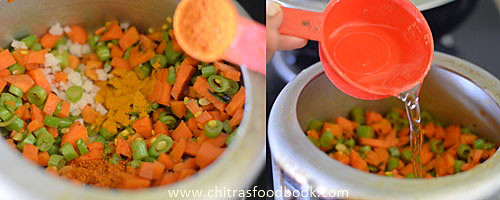
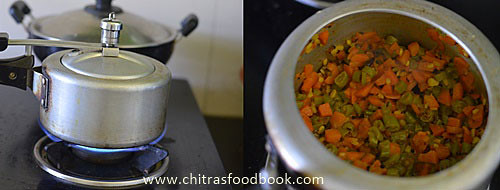 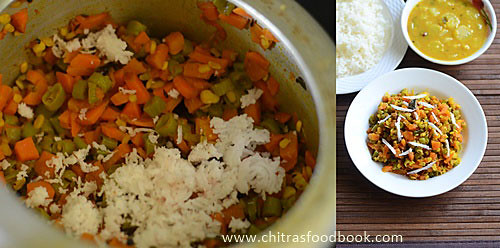 Enjoy ! |
Note
|
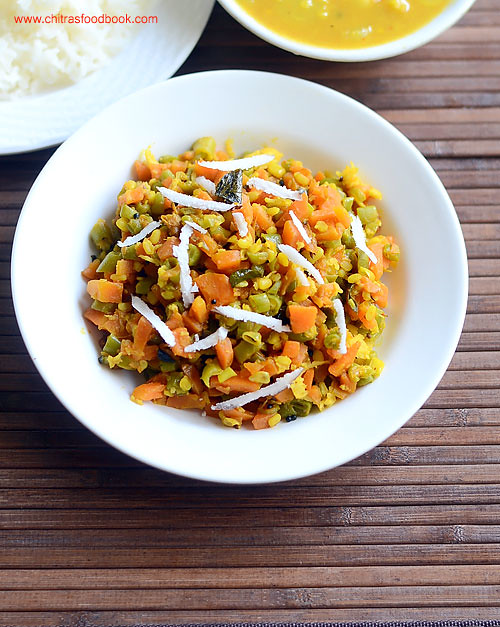
Technorati Tags: carrot beans poriyal,carrot beans poriyal recipe,carrot beans curry,carrot beans curry for rice,carrot beans stir fry,how to make carrot beans poriyal,carrot beans curry recipe,beans carrot poriyal,poriyal recipes,side dish for rice,carrot recipes,beans recipes
March 21, 2016

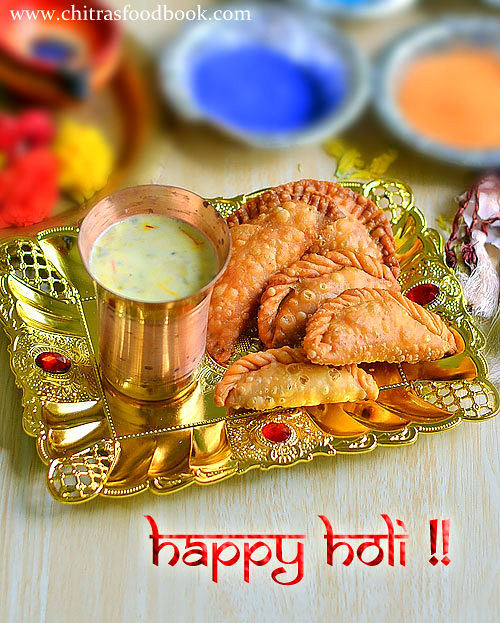
Gujiya Recipe With Mawa, Suji - How To Make Gujiya With Step by Step Pictures

I was very happy & satisfied with the result. Sendhil & Raksha loved it too. So I thought of sharing this wonderful recipe as my contribution to Holi festival recipes. I used khoya/mawa for gujiya filling as mentioned in the original recipe. If you wish to try without khoya, you can replace it with dessicated coconut and powdered nuts. Please refer my Sweet samosa recipe to know its procedure. Try it and share with your friends and relatives on HOLI day !! Have a colorful celebration. Lets see how to make Gujiya recipe with mawa and sooji stuffing with step by step pictures.
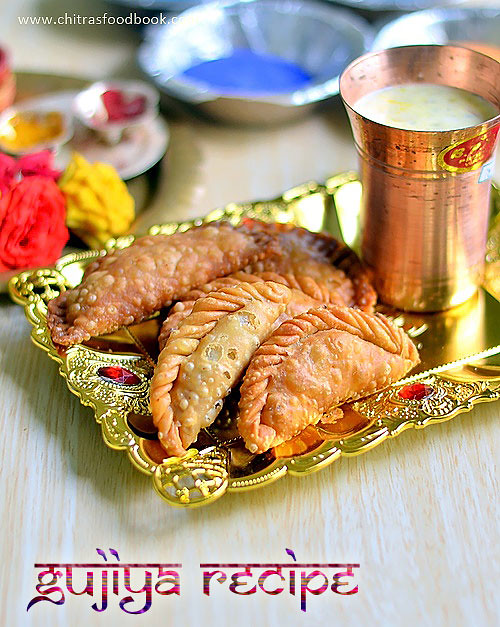
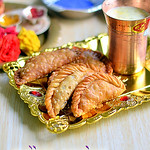 How to make gujiya with khoya/mawa filling - Holi festival recipes
How to make gujiya with khoya/mawa filling - Holi festival recipes
INGREDIENTS
Note
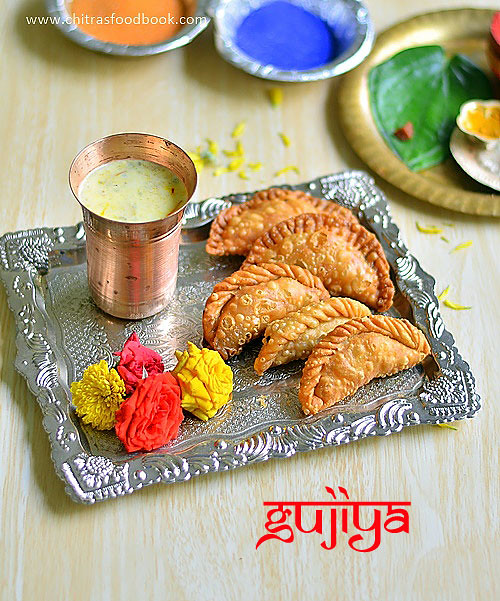

Gujiya recipe
 How to make gujiya with khoya/mawa filling - Holi festival recipes
How to make gujiya with khoya/mawa filling - Holi festival recipes
Cuisine: Indian
Category: Sweet
Serves: 8-10
Prep time: 30 Minutes
Cook time: 20 Minutes
Total time: 50 Minutes
INGREDIENTS
1 cup = 240ml
|
HOW TO MAKE GUJIYA - METHOD
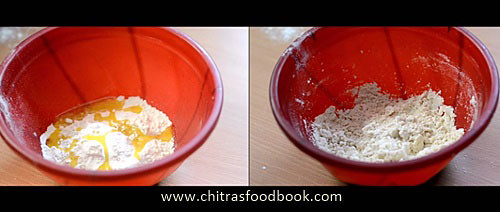 
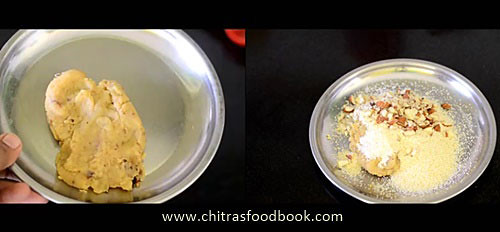 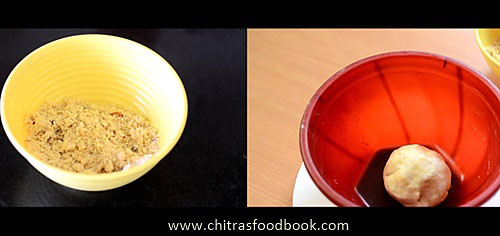
 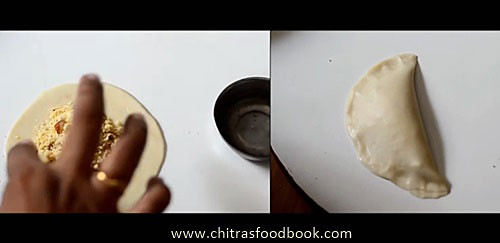 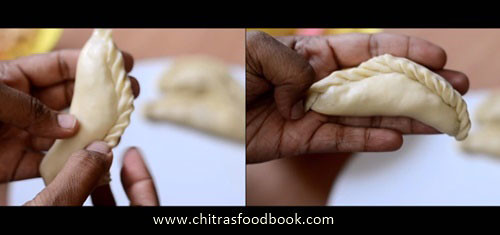

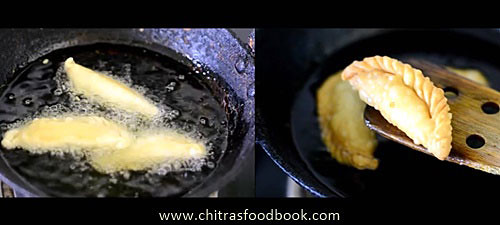 |
|
Enjoy these yummy Gujiya & Thandai on HOLI Day and have a great celebration !

Technorati Tags: Gujiya recipe,gujiya,how to make gujiya at home,gujiya sweet,holi recipes,holi festival recipes,Gujiya recipe with suji,gujiya filling,mawa gujiya
Very good recipes Tags: Gujiya recipe, gujiya, how to make gujiya at home, gujiya sweet, holi recipes, holi festival recipes, Gujiya recipe with suji, gujiya filling, mawa gujiya
March 17, 2016


Mango Sambar Recipe | Mangai Sambar | Raw Mango Recipes

This mango sambar recipe is my MIL’s version which is very easy to make without any grinding job. Its like my basic onion sambar recipe but there are slight variations in the quantity of tamarind and spices as we use sour raw mango here. Whenever my MIL make this sambar, she reserves 2 big mango pieces for me as I love to eat those soft, spicy and juicy cooked mangoes the most. When I was making this sambar, all these nostalgic memories were running behind my mind :)..Ok. Lets see how to prepare this yummy raw mango sambar recipe with step by step pictures !
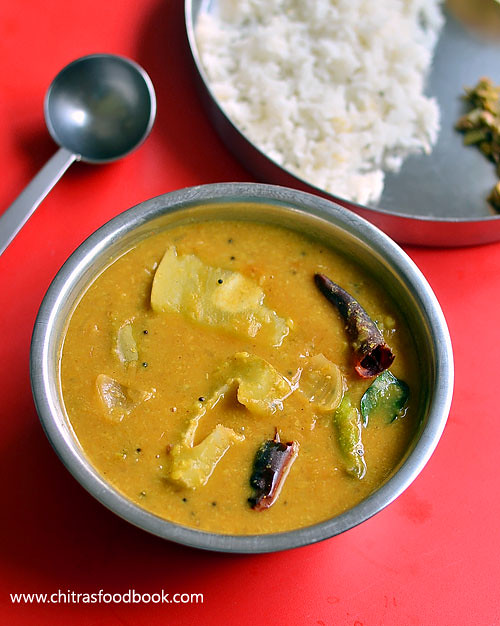
Mango sambar recipe
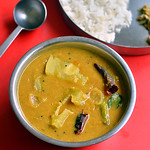 How to make raw mango sambar recipe / mangai sambar for rice
How to make raw mango sambar recipe / mangai sambar for rice
Cuisine: Indian
Category: side dish
Serves: 3
Prep time: 10 Minutes
Cook time: 20 Minutes
Total time: 30 Minutes
INGREDIENTS
| 1 cup = 250ml To pressure cook
|
METHOD
 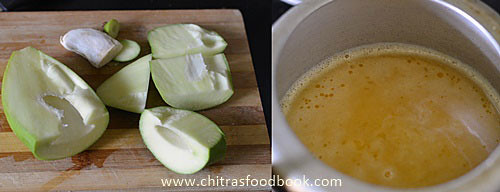
 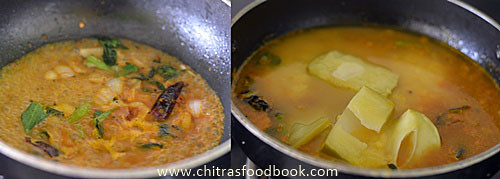
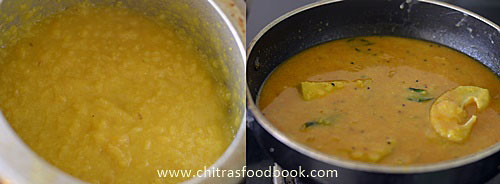 |
Note
| Adjust the quantity of tamarind and sambar powder according to the sourness of mango. You can also use toor dal & moong dal in equal quantity to make this sambar. If you feel the mango is over cooked, remove the pieces after the sambar is done. Add the pieces just before serving so that mango will retain its shape while serving. |
Enjoy this yummy mango sambar for your lunch ! I had with rice & broad beans poriyal.

Technorati Tags: Mango sambar,raw mango sambar,mango sambar recipe,raw mango sambar recipe,how to make mango sambar,how to prepare mango sambar,mango recipes,sambar recipes,sambar for rice,lunch recipes
March 15, 2016

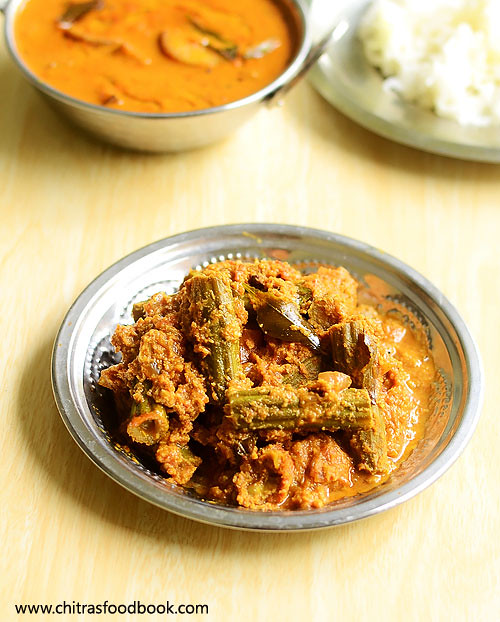
Drumstick Masala – Murungakkai Masala Poriyal Recipe

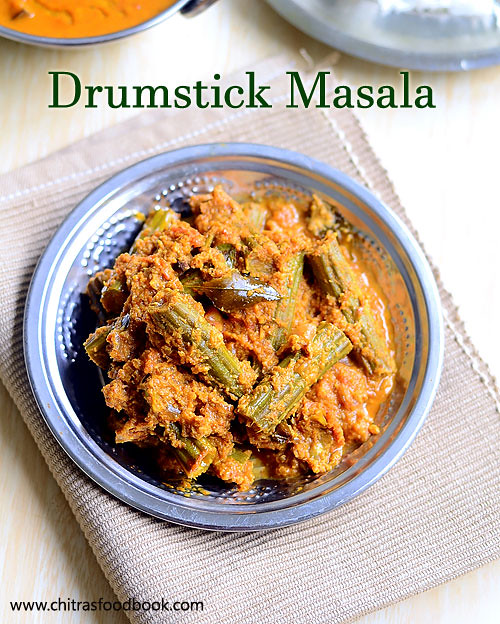
Drumstick/Murungakkai masala recipe
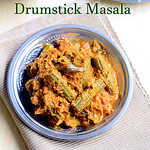 Drumstick/Murungakkai masala recipe for rice
Drumstick/Murungakkai masala recipe for rice
Cuisine: South Indian
Category: Side dish for rice
Serves: Serves 2
Prep time: 10 Minutes
Cook time: 20 Minutes
Total time: 30 Minutes
INGREDIENTS
|
METHOD
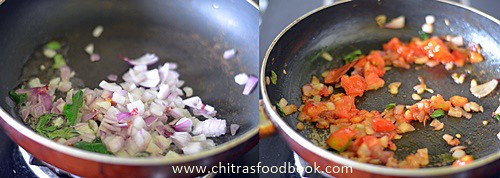
 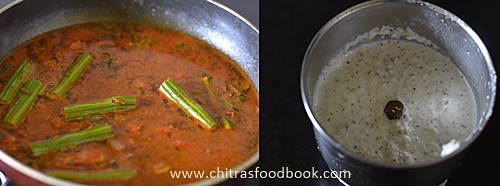
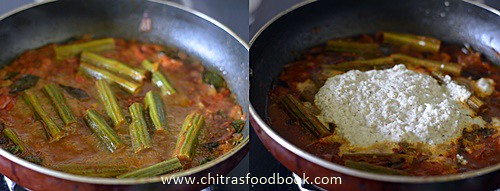 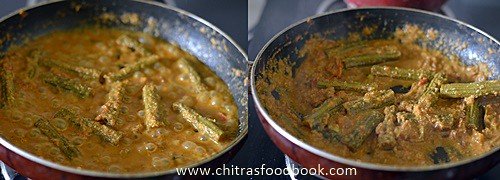 |
Note
|
Try this yummy drumstick masala for rice. It tastes yum !! I served it with Brinjal Kara kuzhambu : ))

Technorati Tags: murungakkai masala,murungakkai masala poriyal,drumstick masala recipe,drumstick masala,drumstick curry,drumstick fry,murungakkai fry recipe,drumstick recipes
March 12, 2016

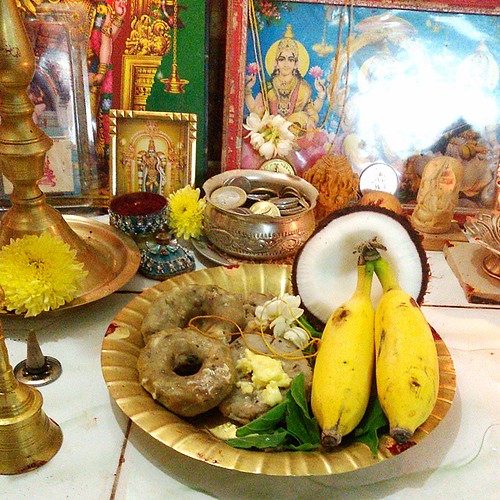
Karadaiyan Nombu Pooja Procedure, Date, Timing, Slokha, Celebration
Karadaiyan Nombu/Nonbu is a traditional festival of fasting observed in remembrance of the Satyavan – Savitri legend. As it is an important festival of South India, I thought of sharing its pooja procedure/Pooja vidhi and the timings for pooja for beginners. I wanted to keep a record of all our festival celebrations in my blog for my future reference. So I started with this festival. There is a story/Katha behind this festival. I have shared it in detail below.
Click this link for nonbu adai recipe(Sweet adai and salt adai) for neivedyam.
A princess, Savitri through her devotion saved her husband, Satyavan, from death. So this festival is also known as Savitri viratham in Tamil / Savitri Vrat in Hindi. On this day, Women observe fasting and pray for the wellness and long life of their husbands. This nonbu/vrat should be done exactly in the time when Tamil month 'Masi' ends and the next month 'Panguni' starts. I have shared the nonbu timings for different parts of world below. Please check it. Fast is observed from the sunrise on the supposed transition day and ends with the Puja.Women break the fast by eating the Karadai (Made of Rice & dal) preparation with unmelted butter by chanting a slokha given below.
In short, the reason why this fasting is carried out is that “ Savithri fought with yema (the God of Death) to save her husband's (Satyavan) life", the same way the married women should fast on this auspicious day for long life of their husbands. Unmarried woman also observe Karadaiyan Nombu and pray to Goddess to get good men as their husband. Prayers are offered to Gowri Devi and women meditate on Savitiri and wear a yellow thread round their neck as they chant the following slokha/slokam.
Click this link for nonbu adai recipe(Sweet adai and salt adai) for neivedyam.
A princess, Savitri through her devotion saved her husband, Satyavan, from death. So this festival is also known as Savitri viratham in Tamil / Savitri Vrat in Hindi. On this day, Women observe fasting and pray for the wellness and long life of their husbands. This nonbu/vrat should be done exactly in the time when Tamil month 'Masi' ends and the next month 'Panguni' starts. I have shared the nonbu timings for different parts of world below. Please check it. Fast is observed from the sunrise on the supposed transition day and ends with the Puja.Women break the fast by eating the Karadai (Made of Rice & dal) preparation with unmelted butter by chanting a slokha given below.
In short, the reason why this fasting is carried out is that “ Savithri fought with yema (the God of Death) to save her husband's (Satyavan) life", the same way the married women should fast on this auspicious day for long life of their husbands. Unmarried woman also observe Karadaiyan Nombu and pray to Goddess to get good men as their husband. Prayers are offered to Gowri Devi and women meditate on Savitiri and wear a yellow thread round their neck as they chant the following slokha/slokam.
Women who are not able to perform this pooja on Nombu day can do this pooja on the following Tuesday or Friday in Panguni month in auspicious time of the day.
The following is the Tamil chant while doing neivedyam.
Urukaadha Venneyum oradaiyam naan nootren
Orukkalum en kanavar ennai vittu pririyadhirukka vendum
"உருகாத வெண்ணெயும் ,ஓர் அடையும் நோற்று உனக்கு நான் வைத்தேன் , எந்நாளும் என் கணவர் எனை விட்டு பிரியாதிருக்க வேண்டும் " என்று அம்மனை நோக்கி வேண்டி நமஸ்கரிக்கவும்.
which means I offer butter and the rice made out of kaar arisi. Bless me that I live happily with my husband for long.
The following is the Tamil chant while doing neivedyam.
Urukaadha Venneyum oradaiyam naan nootren
Orukkalum en kanavar ennai vittu pririyadhirukka vendum
"உருகாத வெண்ணெயும் ,ஓர் அடையும் நோற்று உனக்கு நான் வைத்தேன் , எந்நாளும் என் கணவர் எனை விட்டு பிரியாதிருக்க வேண்டும் " என்று அம்மனை நோக்கி வேண்டி நமஸ்கரிக்கவும்.
which means I offer butter and the rice made out of kaar arisi. Bless me that I live happily with my husband for long.
While tying the rope, recite the following slokha :
ेवनागरी:
दोरं गृह्णामि सुभगे सहारिद्रम् धराम्यहम् |
भर्थु: आयुश् सिद्ध्यर्थं सुप्रीता भव सर्वदा ||
IASTदोरं गृह्णामि सुभगे सहारिद्रम् धराम्यहम् |
भर्थु: आयुश् सिद्ध्यर्थं सुप्रीता भव सर्वदा ||
doraṁ gṛhṇāmi subhage sahāridram dharāmyaham |
bharthu: āyuś siddhyarthaṁ suprītā bhava sarvadā ||
தமிழ்
தோ³ரம்ʼ க்³ருʼஹ்ணாமி ஸுப⁴கே³ ஸஹாரித்³ரம் த⁴ராம்யஹம் |
ப⁴ர்து²: ஆயுஸ்² ஸித்³த்⁴யர்த²ம்ʼ ஸுப்ரீதா ப⁴வ ஸர்வதா³ ||
Meaning : Devi, I am tying this nombu saradu around my neck for the longevity of my husband (Father for unmarried girls). Please bless me.
Please check the video below for Karadaiyan nombu adai recipes.
Story of Karadaiyan Nombu
Savithri was a princess of a rich kingdom in ancient India.She was born as the daughter of King Asrapathi. She was the only child of her parents. When she attained the age of marriage, she told her father that she would herself search for a suitable husband for her. She wished to marry Sathyavan who lived in the forest. Despite being warned by the palace astrologer that he would die within a year of marriage, she married Sathyavan.
Savithri was a princess of a rich kingdom in ancient India.She was born as the daughter of King Asrapathi. She was the only child of her parents. When she attained the age of marriage, she told her father that she would herself search for a suitable husband for her. She wished to marry Sathyavan who lived in the forest. Despite being warned by the palace astrologer that he would die within a year of marriage, she married Sathyavan.
Days passed and the last day of Satyavan's life as per the prediction dawned. On that day, Satyavan made Savitri sit under a tree and went to fetch fruits and logs for fuel. After sometime, he returned feeling very tired. Savitri made him lie in a bed made of fresh green leaves keeping his head in her lap. As Satyavan started closing his eyes, there appeared in front of Savitri, a huge figure with a bison as his vahana. Savitri with her dedication and devotion could immediately recognize the figure as Yama, the God of death.
She immediately saluted him and asked him the purpose of his visit. Yama replied that as destined Satyavan's life span was over and he had come to take his life to the other world. Saying this Yama started walking away with Satyavan's soul. Savitri left the body of the lifeless Satyavan under the tree and started following Yama. Yama forbade her from following him, saying she could not follow him to the other world, as Yama loka was inaccessible to living beings. Only souls of dead beings are taken there. Savitri insisted on following her husband’s soul. Yama could not stop her from following him. At last, Yama agreed to grant her three wishes on condition that she would go back. She agreed.
She immediately saluted him and asked him the purpose of his visit. Yama replied that as destined Satyavan's life span was over and he had come to take his life to the other world. Saying this Yama started walking away with Satyavan's soul. Savitri left the body of the lifeless Satyavan under the tree and started following Yama. Yama forbade her from following him, saying she could not follow him to the other world, as Yama loka was inaccessible to living beings. Only souls of dead beings are taken there. Savitri insisted on following her husband’s soul. Yama could not stop her from following him. At last, Yama agreed to grant her three wishes on condition that she would go back. She agreed.
She asked as the first boon, that her in-laws get back their lost kingdom which Yama granted readily. For the second wish she asked that, as she was the only child of her parents, they get more children. This was also granted by Yama immediately. As the last wish, she asked that she should have many children which also was granted by Yama in his eagerness to get rid of her. Only after granting this wish, Yama realized that he had been tricked into granting Satyavan life, as a pious and pathivratha (chaste) woman like Savitri cannot have children if Satyavan were to be dead. Yama had to accept his defeat and restore the life of Satyavan. Savitri came back to the tree where she had left the lifeless body of Satyavan. By the blessings of Yama, Satyavan woke up as if from his sleep and Savitri narrated the happenings to him.
To offer her gratitude to the Gods, Savitri immediately made a simple neivedyam with available things on hand, Rice & dals and tied the mangala sutra once again as her husband had got back his life. Her offerings were durwa grass and peepal leaves.She performed neivedhyam with wild rice and toor dal. That is kaar arisi and thuvaram paruppu.The preparation is known as Kaaradai nombu adai - the festival takes its name from the unique dish prepared using Kaar arisi. It is believed that Savitri cooked such a dish and offered it to Lord Yama along with unmelted butter as a sort of thanksgiving for sparing her husband’s life. This is how Karadaiyan Nombu festival came into existence. I thank Jaishree for sharing this story in her blog. You can find that in the link below.
Source: https://jaishreesblog.blogspot.in/2008/03/karadayan-nombu.html
Click this link for Karadaiyan nombu Sweet adai & salt adai recipes using homemade rice flour in detail with step by step pictures.
Nombu Timings
In 2024, the date of Karadaiyan Nonbu is March 14th, Thursday.
For India :
To offer her gratitude to the Gods, Savitri immediately made a simple neivedyam with available things on hand, Rice & dals and tied the mangala sutra once again as her husband had got back his life. Her offerings were durwa grass and peepal leaves.She performed neivedhyam with wild rice and toor dal. That is kaar arisi and thuvaram paruppu.The preparation is known as Kaaradai nombu adai - the festival takes its name from the unique dish prepared using Kaar arisi. It is believed that Savitri cooked such a dish and offered it to Lord Yama along with unmelted butter as a sort of thanksgiving for sparing her husband’s life. This is how Karadaiyan Nombu festival came into existence. I thank Jaishree for sharing this story in her blog. You can find that in the link below.
Source: https://jaishreesblog.blogspot.in/2008/03/karadayan-nombu.html
Click this link for Karadaiyan nombu Sweet adai & salt adai recipes using homemade rice flour in detail with step by step pictures.
Nombu Timings
In 2024, the date of Karadaiyan Nonbu is March 14th, Thursday.
For India :
Karadaiyan Nombu Vratham - 09:30 AM to 11:30 AM
Duration - 2 hours (as per vakiya panchangam)
As per Drik Panchang website :
Karadaiyan Nombu on Thursday, March 14, 2024
Karadaiyan Nombu Vratham - 06:32 AM to 12:46 PM
Duration - 06 Hours 15 Mins
Manjal Saradu Muhurtham - 12:46 PM
DO'S & DONT'S
Generally,
1. There is a saying in Tamil, "Maasikkayiru Paasipadarum". It means you have to tie the nonbu saradu (yellow rope) in maasi month itself.
2. Its not auspicious to perform Pooja (Nombu) at midnight (Agaala neram).
3. It is also not auspicious to perform pooja before brahma muhurtham.
4. After 9 pm, Ambal becomes ugra swaroopini from Santha swaroopini as per tantra sastram.
2. Its not auspicious to perform Pooja (Nombu) at midnight (Agaala neram).
3. It is also not auspicious to perform pooja before brahma muhurtham.
4. After 9 pm, Ambal becomes ugra swaroopini from Santha swaroopini as per tantra sastram.
5. Do not drink Buttermilk on this festival day because there is a saying in Tamil " Yezhaiyaar nootra nonbai Mozhaiyaar kondu selvaar".
6. Next day morning, give 2 kaar adais to cow(Pasu maadu) if possible. This was done by Savithri to rescue her husband Sathyavaan from Yaman.
Because of the above mentioned reasons, if the time falls after 9pm for your location, you can do the pooja from 7 pm to 8.30 pm at night. Otherwise you can perform as per the transition muhurtham from maasi to panguni.
Because of the above mentioned reasons, if the time falls after 9pm for your location, you can do the pooja from 7 pm to 8.30 pm at night. Otherwise you can perform as per the transition muhurtham from maasi to panguni.
In United States, For Washington DC
As per Drikpanchang.com
Karadaiyan Nombu on Wednesday, March 13, 2024
Karadaiyan Nombu Vratham - 07:22 AM to 03:16 AM, Mar 14
Duration - 19 Hours 55 Mins
Manjal Saradu Muhurtham - 03:16 AM, Mar 14
For Sunnyvale, California
Karadaiyan Nombu on Wednesday, March 13, 2024
Karadaiyan Nombu Vratham - 07:21 AM to 12:16 AM, Mar 14
Duration - 16 Hours 55 Mins
Manjal Saradu Muhurtham - 12:16 AM, Mar 14
For Newyork, New Jersy
Karadaiyan Nombu on Wednesday, March 13, 2024
Karadaiyan Nombu Vratham - 07:10 AM to 03:16 AM, Mar 14
Duration - 20 Hours 06 Mins
Manjal Saradu Muhurtham - 03:16 AM, Mar 14
Karadaiyan Nombu on Wednesday, March 13, 2024
Karadaiyan Nombu Vratham - 07:05 AM to 12:16 AM, Mar 14
Duration - 17 Hours 11 Mins
Manjal Saradu Muhurtham - 12:16 AM, Mar 14
Australia
Karadaiyan Nombu on Thursday, March 14, 2024
Karadaiyan Nombu Vratham - 07:01 AM to 06:16 PM
Duration - 11 Hours 15 Mins
Manjal Saradu Muhurtham - 06:16 PM
London
Karadaiyan Nombu on Wednesday, March 13, 2024
Karadaiyan Nombu Vratham - 07:03 AM to 03:16 AM, Mar 14
Duration - 20 Hours 14 Mins
Manjal Saradu Muhurtham - 03:16 AM, Mar 14
Singapore
Karadaiyan Nombu on Thursday, March 14, 2024
Karadaiyan Nombu Vratham - 07:11 AM to 03:16 PM
Duration - 08 Hours 06 Mins
Manjal Saradu Muhurtham - 03:16 PM
Malaysia
Karadaiyan Nombu on Thursday, March 14, 2024
Karadaiyan Nombu Vratham - 07:20 AM to 03:16 PM
Duration - 07 Hours 57 Mins
Manjal Saradu Muhurtham - 03:16 PM
Dubai
Karadaiyan Nombu on Thursday, March 14, 2024
Karadaiyan Nombu Vratham - 06:29 AM to 11:16 AM
Duration - 04 Hours 47 Mins
Manjal Saradu Muhurtham - 11:16 AM
Riyadhi, Saudi Arabia
Karadaiyan Nombu on Thursday, March 14, 2024
Karadaiyan Nombu Vratham - 06:03 AM to 10:16 AM
Duration - 04 Hours 14 Mins
Manjal Saradu Muhurtham - 10:16 AM
Amsterdam, Netherlands
Karadaiyan Nombu on Thursday, March 14, 2024
Karadaiyan Nombu Vratham - 06:56 AM to 08:16 AM
Duration - 01 Hour 20 Mins
Manjal Saradu Muhurtham - 08:16 AM
Berlin, Germany
Karadaiyan Nombu on Thursday, March 14, 2024
Karadaiyan Nombu Vratham - 06:22 AM to 08:16 AM
Duration - 01 Hour 54 Mins
Manjal Saradu Muhurtham - 08:16 AM
The timings mentioned here are just approximate ones taken from "Drik Panchang" , If you are looking for accurate timings, please use the link below. Mention your city name ( Anywhere in the world) and find the timings and date.
Please note the time of Maasi ending and Panguni starting varies from country to country. If you wish, you can consult your temple priest or check with elders or refer Panchangam. Avoid Rahu kalam and Yama gandam timings for doing pooja. Better to do it before 9pm on festival day.
Women who are not able to perform this pooja on Nombu day can do it on the following Tuesday or Friday in Panguni month in the auspicious time of the day (Avoid rahu kalam and yama kandam) .
Women who are not able to perform this pooja on Nombu day can do it on the following Tuesday or Friday in Panguni month in the auspicious time of the day (Avoid rahu kalam and yama kandam) .
Ingredients required for Pooja
Click this link for Karadaiyan nombu Sweet adai & salt adai recipes using homemade rice flour in detail with step by step pictures and video.
Click this link for Karadaiyan nombu Sweet adai & salt adai recipes using homemade rice flour in detail with step by step pictures and video.
-
Rice flour paste (for drawing rangoli) – Refer my in-laws blog for kolam ideas
-
Lamps / Vilakku
-
Flowers
-
Betel leaves, nuts, coconut, banana
-
Rice, Legumes ( black eyed peas – We keep a mix of 9 grains) and Unmelted butter.
-
Jaggery, cardamom, green chilli, ginger and seasoning ingredients for making sweet & spicy adai.
-
Camphor, Incense stick.
-
Yellow rope tied with a flower in the center.
- Banana leaf or plates
How to perform pooja
For pre preparatory works, sweep the house the previous day of the festival. Wash the lamps and keep kumkum dots on the eve of festival. Prepare the homemade rice flour, roast and keep it ready for the next day use.
On the festival day morning, we wake up early and take head bath. Draw Rangoli/Padi kolam in the entrance using rice flour paste(Maakolam) and in front of the pooja room. If you are fasting till pooja time, you can just drink milk, lemon juice or consume any fruits. Elders and pregnant ladies can take recipes made of raw rice like upma, idli and any side dish without onion, garlic.
On the festival day morning, we wake up early and take head bath. Draw Rangoli/Padi kolam in the entrance using rice flour paste(Maakolam) and in front of the pooja room. If you are fasting till pooja time, you can just drink milk, lemon juice or consume any fruits. Elders and pregnant ladies can take recipes made of raw rice like upma, idli and any side dish without onion, garlic.
Do not drink buttermilk on this day.
Roast the black eyed peas/ karamani/ thatta payaru and pressure cook for one whistle. Prepare sweet adai by mixing rice flour and cooked peas in jaggery syrup. Similarly prepare salt adai too. Steam both the adai in an idli pot and set aside. After finishing the neivedyam works, decorate the pooja room. Make yellow thread by greasing a thread with turmeric powder. Tie a flower in the center of rope. The number of threads should be equal to the number of woman+girls at home along with one for Goddess Lakshmi. After decorating the pooja room, light the lamps.
Roast the black eyed peas/ karamani/ thatta payaru and pressure cook for one whistle. Prepare sweet adai by mixing rice flour and cooked peas in jaggery syrup. Similarly prepare salt adai too. Steam both the adai in an idli pot and set aside. After finishing the neivedyam works, decorate the pooja room. Make yellow thread by greasing a thread with turmeric powder. Tie a flower in the center of rope. The number of threads should be equal to the number of woman+girls at home along with one for Goddess Lakshmi. After decorating the pooja room, light the lamps.
At the time of pooja, wear a silk saree. Keep the Nombu adai with umelted butter on top of adai in the middle of banana leaf or a plate. Keep the broken coconut, betel leaves, nuts and banana and yellow ropes in the edge of banana leaf or plate (nuni ilai). Do the neivedyam, show the dhoop & dheep. Perform Mangala aarti by chanting the slokha.
"உருகாத வெண்ணெயும் ,ஓர் அடையும் நோற்று உனக்கு நான் வைத்தேன் ,எந்நாளும் என் கணவர் எனை விட்டு நீங்காத அருள் தருவாய்" என்று அம்மனை நோக்கி வேண்டி நமஸ்கரிக்கவும்.
"Urukaadha Venneyum oradaiyam naan nootren
Orukkalum en kanavar ennai vittu pririyadhirukka vendum"
"உருகாத வெண்ணெயும் ,ஓர் அடையும் நோற்று உனக்கு நான் வைத்தேன் ,எந்நாளும் என் கணவர் எனை விட்டு நீங்காத அருள் தருவாய்" என்று அம்மனை நோக்கி வேண்டி நமஸ்கரிக்கவும்.
"Urukaadha Venneyum oradaiyam naan nootren
Orukkalum en kanavar ennai vittu pririyadhirukka vendum"
which means I offer butter and the rice made out of kaar arisi. Bless me that I live happily with my husband for long.
After doing the pooja, chant the following slokha and then tie the yellow rope.
देवनागरी:
दोरं गृह्णामि सुभगे सहारिद्रम् धराम्यहम् |
भर्थु: आयुश् सिद्ध्यर्थं सुप्रीता भव सर्वदा ||
IAST
doraṁ gṛhṇāmi subhage sahāridram dharāmyaham |
bharthu: āyuś siddhyarthaṁ suprītā bhava sarvadā ||
தமிழ்
தோ³ரம்ʼ க்³ருʼஹ்ணாமி ஸுப⁴கே³ ஸஹாரித்³ரம் த⁴ராம்யஹம் |
ப⁴ர்து²: ஆயுஸ்² ஸித்³த்⁴யர்த²ம்ʼ ஸுப்ரீதா ப⁴வ ஸர்வதா³ ||
Meaning : Devi, I am tying this nombu saradu around my neck for the longevity of my husband (Father for unmarried girls). Please bless me.
After finishing the pooja, sit in the same place and tie the yellow rope for Goddess Lakshmi and then tie a rope around your neck by yourself and tie the rope for unmarried girls around their wrist. i.e Married women should tie the thread around the neck by themselves or by a oldest sumangali at home and you can tie the thread for unmarried girls around the wrist.
दोरं गृह्णामि सुभगे सहारिद्रम् धराम्यहम् |
भर्थु: आयुश् सिद्ध्यर्थं सुप्रीता भव सर्वदा ||
IAST
doraṁ gṛhṇāmi subhage sahāridram dharāmyaham |
bharthu: āyuś siddhyarthaṁ suprītā bhava sarvadā ||
தமிழ்
தோ³ரம்ʼ க்³ருʼஹ்ணாமி ஸுப⁴கே³ ஸஹாரித்³ரம் த⁴ராம்யஹம் |
ப⁴ர்து²: ஆயுஸ்² ஸித்³த்⁴யர்த²ம்ʼ ஸுப்ரீதா ப⁴வ ஸர்வதா³ ||
Meaning : Devi, I am tying this nombu saradu around my neck for the longevity of my husband (Father for unmarried girls). Please bless me.
After finishing the pooja, sit in the same place and tie the yellow rope for Goddess Lakshmi and then tie a rope around your neck by yourself and tie the rope for unmarried girls around their wrist. i.e Married women should tie the thread around the neck by themselves or by a oldest sumangali at home and you can tie the thread for unmarried girls around the wrist.
If you wish, you can fall at the feet of your husband and get his blessings. After tying the rope, take one adai along with unmelted butter and eat it. Give the second adai to your husband. Rest of the adai can be distributed to the members of family. This is how Karadaiyan Nonbu is performed in our house. This procedure may differ as per places. Consult the elders about your family practice and do the pooja.
NOTE : The thread you tied around the Lakshmi / Ambal Idol can be removed after few days once its worn out and it should be tied to a plant or dispersed in river water. The thread tied around the women can be tied to the mangal sutra if you wish OR tie it in a plant or branch of a tree. Women who are not able to perform this pooja on Nombu day can do this pooja on the following Tuesday or Friday in Panguni month on the auspicious time of the day.
Click this link for Karadaiyan nombu Sweet adai & salt adai recipes using homemade rice flour in detail with step by step pictures and video.
FRIENDS, IF YOU ARE LOOKING FOR ANOTHER TRADITIONAL NOMBU (As per Tamil brahmins) PROCEDURE AS PER VAITHAKASRI MAGAZINE , PLEASE REFER BELOW:
- Put arisi maa kolam ( Rice flour rangoli) in front of Ambal in pooja room.
- Put one nuni vazhai ilai( Banana leaf) per married women / girl baby in the house.
- The edge of the banana leaf should face North.
- On the edge, place betel leaf & nuts, banana and nombu saradu/yellow rope.
- In the middle, keep two adai / kaar arisi adai with butter on it.
- Keep one extra nombu saradu on the banana leaf of the oldest sumangali/ married women. This is for Ambal/ Goddess.
- If the number of leaves is an odd number like 1,3,5 put one leaf extra and make it to even number like 2, 4, 6.
- Put flower garland for ambal photo and do ashtothra archanai, dhoopam, dheepam.
- Ladies and girls should do prokshanam( sprinkle water 3 times around the banana leaf) saying the following lines.
Oru kaalum ennai vittu en kanavar piriyadhirukka vendum" .
Pray this to Ambal. The oldest sumangali should tie the nombu saradu to ambal Photo. Then she should tie herself around her neck saying the following slokham.
दोरं गृह्णामि सुभगे सहारिद्रम् धराम्यहम् |
भर्थु: आयुश् सिद्ध्यर्थं सुप्रीता भव सर्वदा ||
IAST
doraṁ gṛhṇāmi subhage sahāridram dharāmyaham |
bharthu: āyuś siddhyarthaṁ suprītā bhava sarvadā ||
தமிழ்
தோ³ரம்ʼ க்³ருʼஹ்ணாமி ஸுப⁴கே³ ஸஹாரித்³ரம் த⁴ராம்யஹம் |
ப⁴ர்து²: ஆயுஸ்² ஸித்³த்⁴யர்த²ம்ʼ ஸுப்ரீதா ப⁴வ ஸர்வதா³ ||
Meaning : Devi, I am tying this nombu saradu around my neck for the longevity of my husband (Father for unmarried girls). Please bless me.
After saying this slokha, all the other ladies should say the same and tie the rope in front of Ambal photo.
Eat one kaar adai from your respective banana leaf. Other one is for your husband.
There is a saying in Tamil, "Eezhaiyaar notra nombai mozhaiyaar kondu selvaar".
So on the whole day, avoid buttermilk. Next day morning, give 2 kaar adais to cow (Pasu maadu) if possible. This was done by Savithri to rescue her husband Sathyavaan from Yaman.
Thanks Vaithikasri for the information.
www.vaithikasri.com
I hope beginners would find this post useful for performing this pooja. Have a blessed day !
Thanks for visiting this page.
Subscribe to:
Posts
(
Atom
)
